SINGER 580 User Manual [en, es, fr]
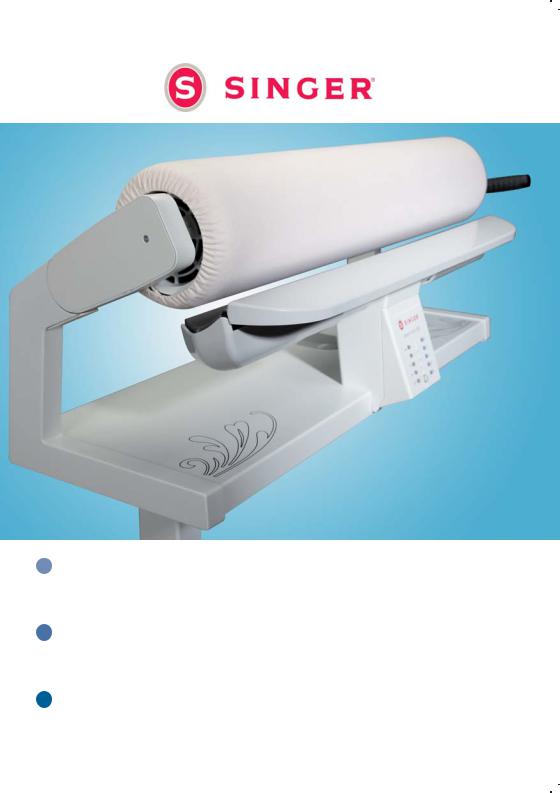
ROTARY STEAM IRON
INSTRUCTION MANUAL (ENGLISH) . . . . . . . . . . . . . . . . . . |
1 |
ROULEAU DE REPASSAGE À LA VAPEUR
MANUEL D’INSTRUCTION (FRANÇAIS) . . . . . . . . . . . . . . . 25
PLANCHA DE RODILLO CON VAPOR
MANUAL DE INSTRUCCIONES (ESPAÑOL) . . . . . . . . . . . . |
49 |

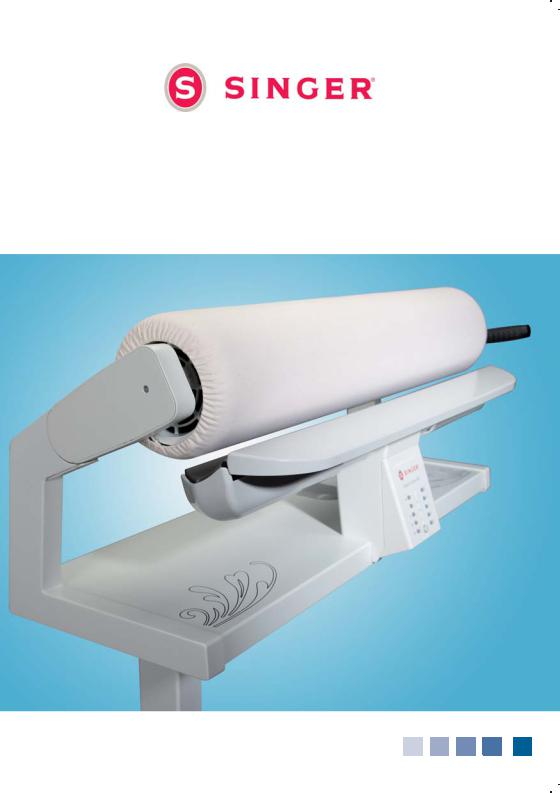
ROTARY STEAM IRON
INSTRUCTION MANUAL
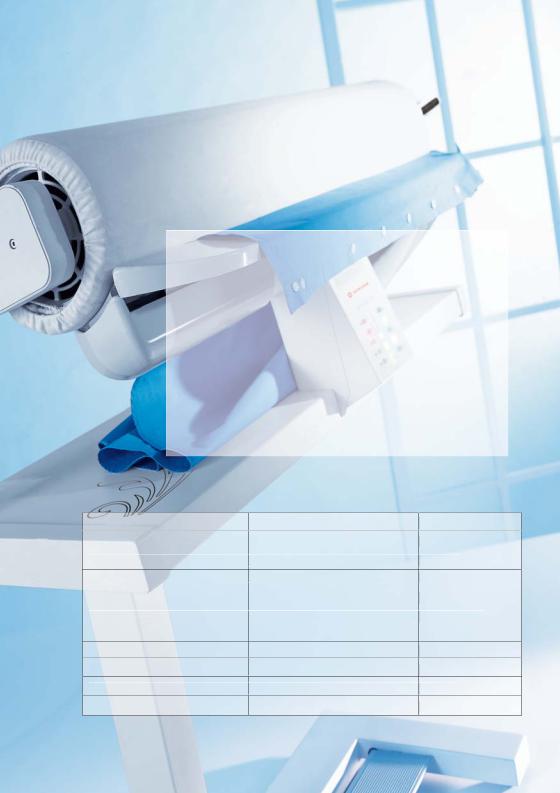
INTRODUCTION
Congratulations on the purchase of your new SINGER®
Rotary Steam Iron!
You have acquired an extremely user-friendly, quality product offering unique advantages for ironing. Your new SINGER® Rotary Steam Iron enables you to iron when seated, without exertion. You will experience top-class ironing comfort!
Take time to read your Instruction Manual thoroughly. It will help you get to know all the features and how to fully use them.
TECHNICAL SPECIFICATIONS
Dimension, Working Position |
36,5“ W x 13“ D x 41“ H |
94/40/105 cm |
Dimension, Folded Down Position |
20,47“ W x 17,75“ D x 39,40“ H |
52/40/100 cm |
Weight |
85 lbs |
39 kg |
Roller Size |
33“ |
84 cm |
Water Tank Capacity |
2,74 pints |
1,3 L |
Excess Temperature Fuse |
421/500 F |
216/260 °C |
(steam generator / heating shoe) |
|
|
Nominal Voltage (60 Hz) |
120V |
120 V |
Power Consumption ( max.) |
1,8 kW |
1,8 kW |
Fuse ( home wiring ) at least |
16 A |
16 A |
Ironing Speed (rpm) |
2,40 - 6,80 |
2,40 - 6,80 |

TABLE OF CONTENTS
• |
Introduction |
2 |
• Part list for the rotary steam iron |
4 |
|
• |
Important safety instructions |
5 |
FUNCTIONS |
|
|
• Setting Up the Rotary Steam Iron |
6 |
|
• Folding the Rotary Steam Iron for Storage |
6 |
|
• Using the Foot Pedal |
7 |
|
• |
Manual Release Lever |
8 |
PREPARING FOR STEAM |
|
|
GENERATION |
|
|
• Water Which May Be Used |
10 |
|
• Water Which May Not Be Used |
10 |
|
• |
Filling the Water Tank |
10 |
•General Information on Descaling Granulate 11
•Checking Descaling Cartridge
|
Placement for Initial Machine Use |
11 |
FUNCTIONS & SETTINGS |
|
|
FOR IRONING |
|
|
• Functions of Operator’s Console |
12 |
|
• |
Ironing Settings |
13 |
HOW TO USE |
|
|
• |
General Information |
14 |
• Ironing Small Flat Items |
14 |
|
• Ironing Larger Flat Items |
15 |
|
• |
Ironing Bed Linens |
15 |
• |
Ironing T-shirts and Knit Tops |
16 |
• Ironing Shirts or Blouses |
17 |
|
• |
Ironing Trousers |
19 |
• Ironing Ruffles or Folds |
19 |
|
CARE & MAINTENANCE |
|
|
• |
General Care |
20 |
• |
Replacing or Renewing |
|
|
the Ironing Roller Covers |
20 |
• Unwinding the Ironing Covers |
20 |
|
• Winding the Ironing Covers |
21 |
|
• |
Empty the Water Tank |
23 |
TECHNICAL SPECS & WARRANTY |
|
|
INFORMATION |
|
|
• |
Warranty & Repair |
24 |
• |
Technical Specifi cations |
24 |
3
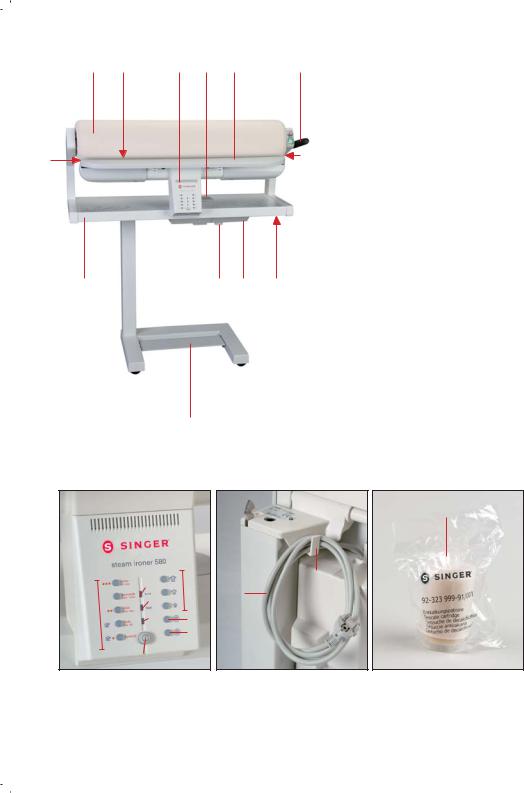
1 |
2 |
3 |
4 |
5 |
7
11 |
10 |
9 |
12
PARTS LIST FOR THE ROTARY 6 STEAM IRON
1 |
Ironing roller |
2 |
Heating shoe with steam slot |
3 |
Operator’s console control buttons |
4 |
Filler opening with lime descaling cartridge |
7 5 |
Support plate |
6 |
Manual release lever |
7 |
Free heating shoe ends |
8 |
Bolt for unfolding |
9 |
Water tank |
10Drain plug
11Collecting table
12Foot pedal
813 Power button
14 Heat Setting buttons with red LEDs
15 Continuous Steam button with blue LED
16 Demand Steam button with blue LED
17 Steam Setting buttons with blue LEDs
18 Power On button with green LED
19 Remaining Water button with blue LED
20 Descaling Granulate Used button with blue LED
21 Locking lever for unfolding
22 Identifi cation plate
23 Power cable
24 Cable hook
25 Spare lime descaling cartridge
21 |
|
|
|
22 |
25 |
|
|||||
|
|
24
|
20 |
17 |
23 |
|
19 |
||
14 |
|
|
|
18 |
16 |
|
|
|
|
||
|
|
15 |
|
|
13 |
|
|
4

IMPORTANT SAFETY INSTRUCTION
1.Read all instructions.
2.Use appliance only for its intended use.
3.To reduce the risk of electric shock, do not immerse the appliance in water or other liquids.
4.Never pull power cord to disconnect from outlet; instead, grasp plug and pull to disconnect. Do not handle the plug with wet hands.
5.Do not allow cord to touch hot surfaces. Let appliance cool completely before putting away. Loop cord loosely on cord hook when storing.
6.Always disconnect appliance from electrical outlet when fi lling with water, when emptying water tank, and when not in use.
7.Do not operate appliance with a damaged cord, or if appliance has been dropped or damaged. To reduce the risk of electric shock, do not disassemble or attempt to repair appliance.
8.Unplug power plug before fi lling or draining water tank, before leaving the room (even briefl y), before cleaning and maintenance and after use.
9.Close supervision is necessary for any appliance being used by or near children. Do not leave appliance unattended while connected. Keep children and pets away from the Rotary Steam Iron.
10.Caution! There is a danger of burning when touching hot parts of the Rotary Steam Iron. Burns could occur from touching hot metal parts, hot water, or steam. Use care when you turn a steam appliance upside down – there may be hot water in the reservoir.
11.Only connect the Rotary Steam Iron to a power supply at the voltage shown on the identifi cation plate. All power carrying devices (sockets, switches, extension cables, house fuse, etc.) must be designed for a power rating that is equivalent to the power supply requirement of the Rotary Steam Iron as shown on the identifi cation plate and guarantee proper protective grounding. To avoid overloading, do not connect any other appliances or electric devices to this circuit.
12.If an extension cord is absolutely necessary, be sure the cord has an ampere rating in accordance with the ampere rating of the Rotary Steam Iron. Cords rated for less amperage may overheat. Care should be taken to arrange the cord so that the cord cannot be pulled or tripped over.
13.The Rotary Steam Iron may only be used to iron garments and other items in accordance with proper use.
14.Do not install the Rotary Steam Iron in rooms subjected to frost. Never switch“on”the Rotary Steam Iron when frozen. The Rotary Steam Iron should be operated in normal room ambient temperatures and humidity. If the Rotary Steam Iron is subjected to frost somehow, it should be plugged in only after the condensation on the machine is completely dried out.
15.Switch on the Rotary Steam Iron only when it is in the unfolded and upright position.
16.Do not place objects in openings of the unit that are required to be clear.
17.Do not use the Rotary Steam Iron if the power cable or other power devices are damaged, if there are doubts regarding the safety or danger due to unseen damage (for example, internal damage if the unit has fallen over), if there is visible damage, if the unit is malfunctioning, or if the collecting table is wet (for example, if the water tank has been over-fi lled).
18.Switch off the power only when the ironing roller is completely raised.
SAVE THESE INSTRUCTIONS. For household use only.
5
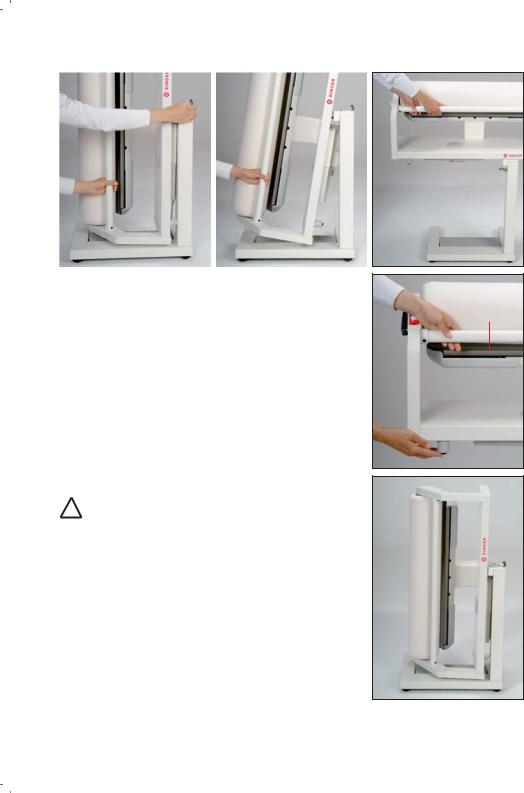
Functions
1 |
|
2 |
|
|
|
SETTING UP THE ROTARY STEAM IRON
1.To set up your Rotary Steam Iron, fi rst unhook the power cable. With your left hand, tightly grip the Connecting Rod (A) in the lower third area. With your right hand, push the Locking Lever forward and hold it pressed. To prevent the Rotary Steam Iron from rolling away, place one foot in front of or on the frame.
2.Raise the ironer slightly and then release the Locking Lever.
3.Now raise the Rotary Steam Iron with both hands up till it stops in the fully upright position, making sure that the Locking Lever engages. You should hear it click into place. The Rotary Steam Iron can be easily rolled on its rollers.
4.Connect the power cable plug of the Rotary Steam Iron into the socket.
! |
Note: Remove the protective paper (wrapped around the ironing |
roller for shipping) and discard it. |
FOLDING THE ROTARY STEAM IRON FOR STORAGE
5.Before folding the Rotary Steam Iron, unplug the power cable from the socket. The Rotary Steam Iron must be completely cooled down. With the left hand, grip the connecting rod and raise it slightly. Push the bolt, located on the underside of the collecting table, with your right hand until it disengages.
6.Allow the ironing roller to lower slowly until you hear it engage the locking mechanism. The Rotary Steam Iron can be easily rolled on its rollers.
3
A
4
5
6
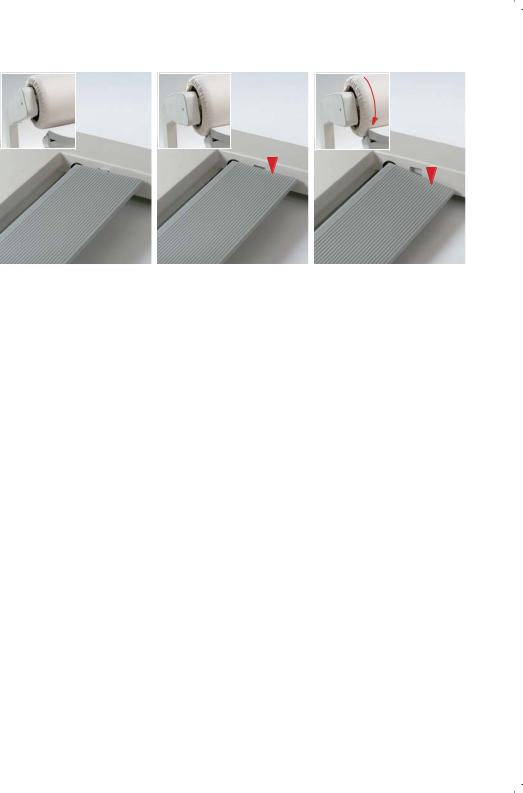
Functions
|
A |
|
|
B |
|
|
C |
|
|
|
|
|
|
|
|
|
|
|
|
|
|
|
|
|
|
|
|
|
|
|
|
|
|
|
|
|
|
|
|
USING THE FOOT PEDAL
The Foot Pedal is used to control the raising and lowering of the ironing roller, as well as its speed. There are 3 positions:
A, B and C.
Position A is the Starting Position. The roller remains in the raised position. The Foot Pedal is not in use.
Position B is the Press Position. The roller is lowered and ready for pressing when you apply light pressure to the Foot Pedal.
Positions C is the Working Position. The roller is lowered and rotating. In Position C, the Rotary Steam Iron has an electronic speed control. The more you step on the foot pedal, the faster the roller will rotate.
Note: The SINGER® Rotary Steam Iron is fi tted with an energy-saving circuit. If the foot pedal is not operated for up to 8 minutes, the heater and steam generator are automatically switched off. When the foot pedal is pressed again, the heating shoe, and if appropriate, the steam generator, are switched on again. The most recently set ironing setting has been reached only when no LEDs are fl ashing. Ironing can then be continued.
7
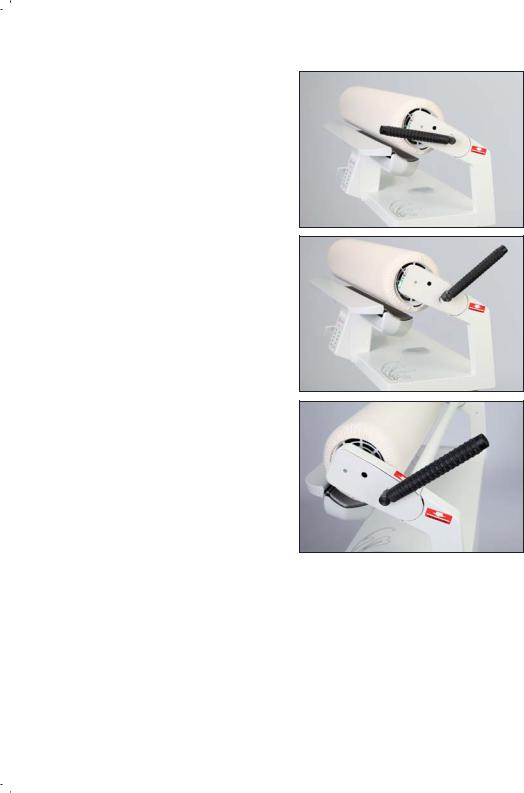
Functions
MANUAL RELEASE LEVER
Your Rotary Steam Iron is equipped with a manual lever. Use it only when needed and according to the instructions. The manual lever has two functions:
Manual Release
Manual release lever is used in the event of an unexpected interruption of the ironing roller, for example, if there is a power failure. The manual release prevents any damage to your garment and the ironing cover due to heat.
To operate, push the release lever manually back to the red strip located on the top of the unit which is approximately 100° from the original position of the lever (see picture).
This will raise the iron roller from the heating shoe and enable user to remove the garment safely.
The manual release lever cannot reset until the power is on and the ironing roller has reached the press position. To do this, pull the manual lever completely forward to the original position.
8
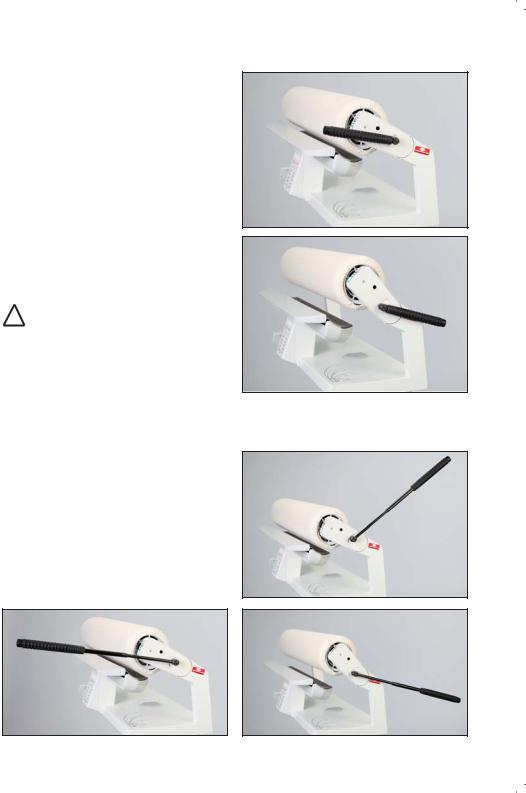
Manual Release for Service Case
When needed, it is possible to raise the iron roller to a service position.
You can raise the iron roller to this position only when the power is turned Off. The roller must be in non-ironing position (roller up).
To operate, push the release lever manually back to the red strip located on the side of the unit which is approximately 180° from the original position of the lever (see picture).
The ironing roller is raised to the service position - two inches over the heating shoe. To return the roller back, pull the manual release lever completely forward to the original position.
! |
Note: Never switch ON the Rotary Steam Iron when |
the ironing roller is raised to the service position. |
About the telescopic mechanism of the lever:
The release lever has a telescopic feature to simplify the use of the lever. If you have difficulty in pushing the lever in folded position, then pull to unfold the telescopic arm. This will reduce the force necessary for moving the lever in both directions.
Return the telescopic lever back to the folded position after usage.
A
Functions
B
C
9

Steam generation
PREPARING FOR STEAM GENERATION
In this chapter, we will cover information on suitable water for steam generation, how to use the water tank, lime descaling cartridge and lime descaling granulate.
The SINGER® Rotary Steam Iron can be operated without water, but for a crease-free result, the steam should be switched on. The steam is applied from below and ensures complete steam penetration of the items being ironed.
WATER WHICH MAY BE USED
1.Tap Water
The Rotary Steam Iron can be operated using normal tap water regardless of its hardness. However, tap water should be used only in conjunction with the lime descaling granulate supplied.
2.Distilled Water
Distilled water is available at most grocery stores. It can be used without the descaling granulate.
WATER WHICH MAY NOT BE USED
1.Water with Additives
On no account must starch, fabric conditioner, perfume or fi nishers be added. For this reason, water from condenser tumble driers may not be used, as this may also contain additives such as fabric conditioners. No liability is accepted for damage to your rotary steam iron or your laundry caused by this.
2.Water from Domestic Water Softening Systems
Domestic water softening systems remove lime from the water but add other substances to the system, depending on the descaling system. This water is therefore not suitable for the Rotary Steam Iron.
FILLING THE WATER TANK
The Remaining Water LED illuminates blue if there is no water, or if there is only 10% water in the water tank. The water tank must now be fi lled before any further steam ironing is done.
Switch off the power and unplug the machine.
1.Pull upward on the cap of the fi ller opening. The lime descaling cartridge is in the fi ller opening.
2.Remove the lime decaling cartridge. You may need to loosen the cartridge by a sideways movement (wiggle it). Then, turn the cartridge clockwise while pulling it upwards
A
1 |
2 |
|
|
10
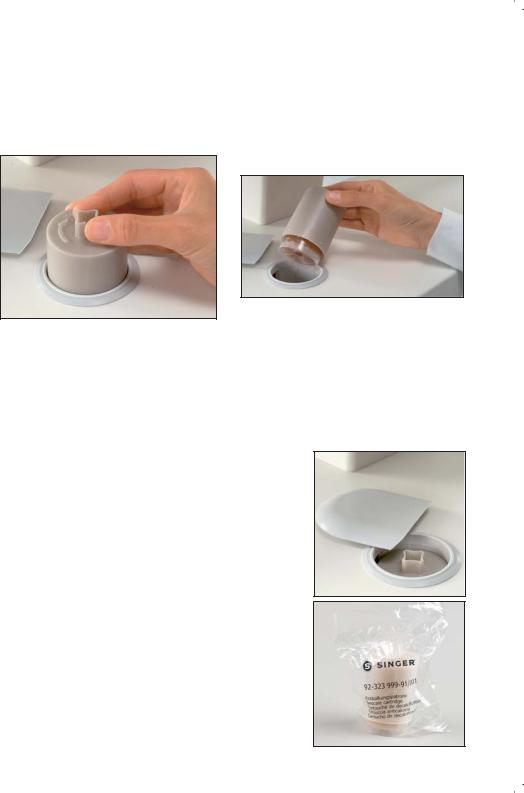
Steam generation
3.Slowly fi ll with water up to the bottom of the fi ller opening (see illustration). Do not fi ll with hot water. For the water level indicator to function properly, after the Remaining Water LED indicator has illuminated, top up with at least 10 ounces (0.3 liters).
3
Total tank capacity is 2.74 pints (1.3 liters) with a descaling cartridge.
The total tank capacity is 2.95 pints (1.4 liters) without a descaling cartridge.
4.Replace the lime descaling cartridge and press the cap onto the fi ller opening.
4
Note: The fi ller opening must always be kept closed to prevent the water supply from becoming contaminated.There is a delay in the steam development after an empty water tank has been fi lled or if a new descaling granulate cartridge has been inserted.
GENERAL INFORMATION ON DESCALING GRANULATE
The descaling granulate in the lime descaling cartridge must always remain slightly damp. Where there are long intervals between ironing (with the water tank empty) the decaling granulate must be moistened with water or kept apart from the Rotary Steam Iron in a sealed plastic bag.
The water tank must be emptied during very long intervals between ironing.
New, full descaling cartridges are available by visiting the SINGER website at: www.singerco.com.
CHECKING DESCALING CARTRIDGE PLACEMENT FOR INITIAL MACHINE USE
The SINGER® Rotary Steam Iron is supplied with a lime descaling cartridge inserted in the water tank. The cartridge is placed below the cap of the fi ller.
1.Switch off the power and unplug the Rotary Steam Iron before removing/replacing the cartridge. Remove the cap by pulling it upwards and make sure that the descaling cartridge is pushed down fully. Press the cap onto the fi ller opening.
2.There is one spare cartridge supplied in a plastic bag with your Rotary Steam Iron. You should keep the spare cartridge in the plastic bag until necessary to replace it in the Rotary Steam Iron, to prevent the granulate in the descaling cartridge from drying out.
If the Descaling Granulate Used display LED is triggered approximately one minute after inserting a lime descaling cartridge, proceed as follows:
Switch off the power and unplug.
Open the cap and push the lime descaling cartridge down fully into position. Replace the cap.
Plug in the Rotary Steam Iron again and switch on the power.
1
2
11
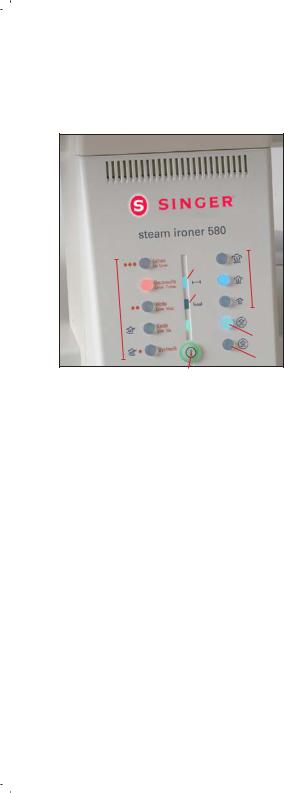
Functions & Settings
FUNCTIONS & SETTINGS FOR IRONING
This chapter provides information on all the electronic functions of your SINGER® Rotary Steam Iron, as well as recommended settings for ironing various garments and other items.
20
17
19
14
 18
18
16
15
13
FUNCTION OF OPERATOR’S CONSOLE
Power Switch button
Immediately after the Power Switch button (13) is turned on, the Power On green LED (18) illuminates. The LED of the preselected heat setting (14) fl ashes red until the selected temperature is reached. It then changes to a steady light.
Note: Do not switch off the power until the ironing roller has been completely raised from the heating shoe.
Remaining Water Level display
The Remaining Water LED (19) illuminates blue if there is no water, or if there is only 10% water in the water tank. The water tank must now be fi lled before any further steam ironing is done.
Descaling Granulate Used display
The Descaling Granulate Used LED (20) illuminates blue when the descaling granulate in the lime descaling cartridge has been used up.
Heat Settings buttons
The red LED of the preselected Heat Setting (14) fl ashes when the Rotary Steam Iron is switched on. Select the required heat setting for ironing and wait until the corresponding LED shows a steady red light. If a new temperature setting is selected (including a lower setting), the corresponding LED fl ashes until the selected temperature is reached. The Rotary Steam Iron has fi ve different heat settings: Synthetic, Silk, Wool, Cotton and Linen.
Note: Ironing with steam is not possible at heat settings of Synthetic and Silk. This is indicated by symbols on the Operator’s Console.
Continuous Steam button
When Continuous Steam (15) is pressed, the LED illuminates blue. At the same time one of the buttons for steam settings (17 A, B or C) fl ashes blue until the steam generator has heated up. The LED then remains illuminated and steam generation begins. The Rotary Steam Iron now produces steam, even if the foot pedal is not pressed and it is possible to select between three steam settings (minimum A, medium B or maximum C).
Demand Steam button
When the Demand Steam button (16) is pressed, the LED illuminates blue. At the same time one of the buttons for steam settings (17 A, B or C) fl ashes blue until the steam generator has heated up. The LED then remains illuminated and steam generation begins. It is now possible to select between three steam settings: (minimum A, medium B and maximum C).
The Rotary Steam Iron now only produces steam when the foot pedal is pressed in the B and C position.
Steam Setting buttons
By means of three buttons – 17 A, B and C – it is possible to vary the amount of steam for the different steam settings: 17A for minimum steam, 17B for medium steam and 17C for maximum steam. The corresponding LED fl ashes until the steam generator has heated up. The LED then remains illuminated and steam generation begins.
12
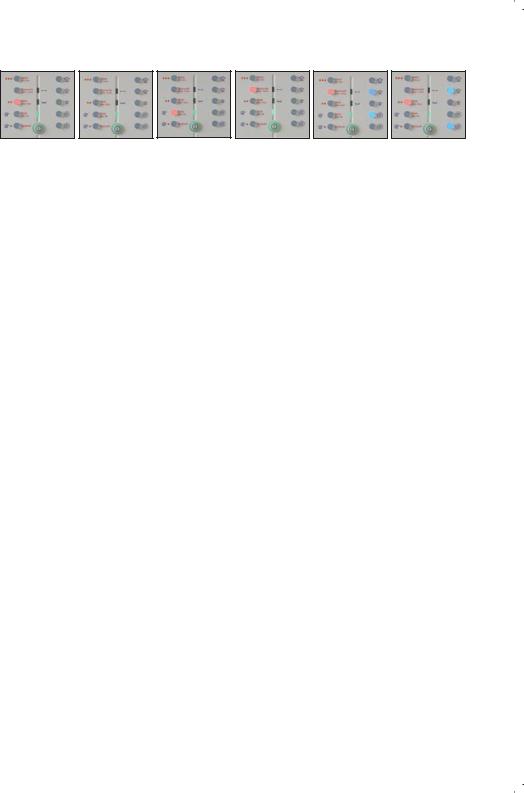
Functions & Settings
1 |
2 |
3 |
IRONING SETTINGS
Ironing without Steam
Immediately after the Power Switch is switched on, the green LED Power On illuminates. The LED of the preselected Heat Setting fl ashes red. Select the required temperature setting for ironing and wait until the corresponding red LED illuminates steadily. The heating shoe temperature is automatically reheated during ironing. If a new temperature setting is selected (including a lower setting), the corresponding LED fl ashes until the selected heating shoe temperature is reached.
(Illustration 1 – heat setting of Wool without steam)
If the current temperature setting is selected again, the heater is switched off and the red LED goes out. The heater is now switched off but your Rotary Steam Iron remains ready for use.
(Illustration 2 – heating shoe will be cooling off but the roller will still move)
If the temperature is set to Synthetic or Silk, it is not possible to iron with steam.
(Illustration 3)
Note: When ironing without steam, the garment should be still slightly damp or dampened, i.e., sprayed with water, to achieve the best results.
Ironing with Demand Steam
The Rotary Steam Iron steams only when the foot pedal is in position B or C. It is now possible to select between 3 steam settings: Minimum, Medium, and Maximum. This means that less energy and water are used when not needed.
Immediately after the Power Switch is switched on, the green LED Power On illuminates. Select the required temperature setting Wool, Cotton or Linen for ironing and wait until the corresponding red LED illuminates steadily. The heating shoe temperature is automatically maintained during ironing. If a new temperature setting is selected (including a lower setting), the corresponding LED fl ashes until the selected heating the temperature is reached.
(Illustration 4 – heat setting of Cotton without steam)
If the current temperature setting is selected again, the heater is switched off and the red and blue LED goes out. The heater
4 |
5 |
6 |
is now switched off but your Rotary Steam Iron remains ready for used.
(Illustration 2 – heating shoe will be cooling off but the roller will still move)
When the Demand Steam Button is pressed, the blue LED illuminates. At the same time, the blue steam setting button (in the medium position) fl ashes until the steam generator has heated up. The LED then remains illuminated and steam generation begins. Select one of the three steam settings.
(Illustration 5)
Ironing with Continuous Steam
The Rotary Steam Iron steams even if the foot pedal is not press and you can select between the three steam settings: Minimum, Medium and Maximum, to match the amount of steam to the garment and thus obtain the best result.
Ironing with continuous steam is suitable for ironing wool pullovers or velvet garments that are not to be pressed. Instead, these are smoothed by passing them over the heating shoe and the continuous steam with the ironing roller in the raised position.
Immediately after the Power Switch is switched on, the green LED Power On illuminates. Select the required temperature setting Wool, Cotton or Linen for ironing and wait until the corresponding red LED illuminates steadily.
The heating shoe temperature is automatically reheated during ironing. If a new temperature setting is selected (including a lower setting), the corresponding LED fl ashes until the selected heating shoe temperature is reached.
(Illustration 1)
When the Continuous Steam button is pressed, the blue LED illuminates. At the same time, the medium blue steam setting fl ashes until the steam generator has heated up. The LED then remains illuminated and steam generation begins. Select one of the three steam settings.
(Illustration 6)
After Ironing
Press the Power Switch. The green LED goes out. Now unplug from the socket.
Do not fold the Rotary Steam Iron until it has fully cooled down!
13
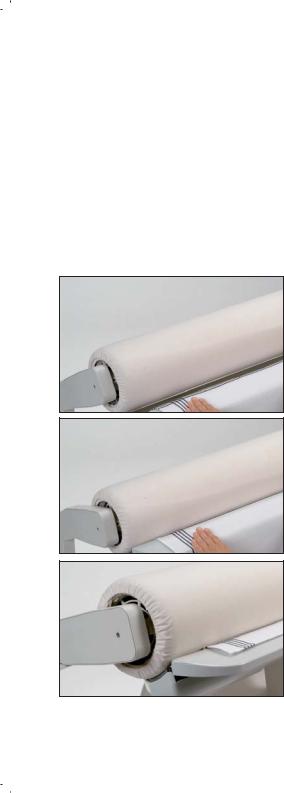
How to use
HOW TO USE
This chapter contains step-by-step instructions on how to iron various types of garments and home décor items with your SINGER® Rotary Steam Iron.
GENERAL INFORMATION
Before ironing with your Rotary Steam Iron, check the care labels of your items for any specifi c care instructions.
Place the item in position so that any zippers, buttons, hooks, etc, face upward towards the roller.
It is possible to iron without steam, with demand steam or with continuous steam.
For some materials such wool sweaters or fabrics with pile (such as velvet or corduroy), the use of the iron roller for press-
1
ing or ironing is not recommended. Instead, the garment should be drawn over the steam slot in Continuous Steam mode.
The large ironing area also enables bed linens and table cloths to be ironed without difficulty. The large collecting table holds the garments fl at after ironing.
After ironing, lay the garments together and allow them to cool.
IRONING SMALL FLAT ITEMS
1.To iron smaller, fl at items such as tea towels, napkins, placemats, etc, place the item on the support plate and slide it between the heating shoe and iron roller so that it is caught by the roller when the foot pedal is pressed.
2.Allow the item to run through.
3.The ironed item is automatically folded on the collecting table.
2
3
14

How to use
IRONING LARGE FLAT ITEMS
To iron larger, fl at items such as tablecloths, the center section of the fabric is pressed fi rst, then the sides of the tablecloth are pressed.
1.Place the tablecloth centered over the heating shoe with the ends of the tablecloth falling off each end of the heating shoe. Press the center section of the tablecloth.
2.With the roller in the raised position, gently pull the fabric back towards you over the heating shoe.
3.Softly fold the tablecloth in half and place the tablecloth so that the ironed part hangs over at one end of the heating shoe. This will prevent pressing a crease into the center of the tablecloth.
4.Placing your index fi nger between the two layers of fabric will act as a guide and allow you greater control as the tablecloth to feeds through, helping to eliminate the any unwanted creases. If necessary, turn over the table cloth and iron it on the other side.
1
3
IRONING BED LINENS
Bed linens, such as duvet covers, can be ironed either from the left or right side. In either case, button it up or zip it fi rst, making sure that the buttons or zipper face upward toward the ironing roller.
Because a duvet cover consists of two layers of fabric, it should not be folded for ironing. A cover must be ironed section by section. Where there is heavy creasing, it should be ironed from both sides.
Duvet covers are basically ironed in the lengthwise direction starting from the buttonhole/zipper side.
Begin at one end of the cover and iron the necessary sections. Each time, pull the duvet cover forward, out over the heating shoe and position it again.
2
4
15

How to use
IRONING T-SHIRTS OR KNIT TOPS
1.When ironing T-shirts or other types of knit tops, begin with the sleeves. Insert the sleeve of the T-shirt at a slant (side seam parallel to the roller) and iron it up to the sleeve seam.
2.For T-shirts with long sleeves, the sleeves should fi rst be ironed up to the cuff, starting from the middle.
3.Then, insert the sleeve of the T-shirt at a slant to the elbow height (side seam parallel to the roller) and iron it from the center up to the sleeve seam.
4.Now pull the T-shirt over one end of the heating shoe, fi rst iron the back, then the side seam. Finally, iron the front and second side seam.
5.When ironing side seams, pull the T-shirt outwards each time so that the area under the sleeves can be ironed easily.
1 |
|
2 |
3 |
|
4 |
|
|
|
5
16
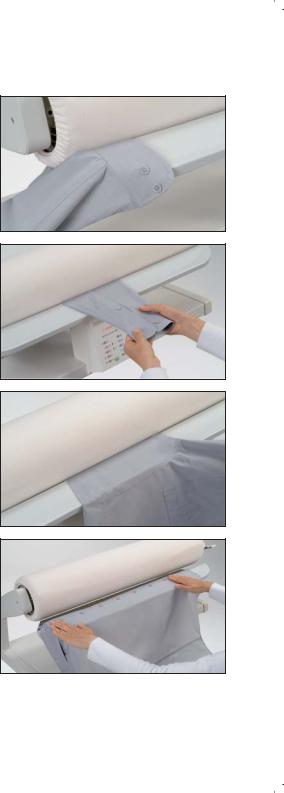
IRONING SHIRTS OR BLOUSES
1.Place the cuff on the end of the heating shoe and iron it. Repeat the process for the second cuff.
2.Now insert the sleeve of the shirt to elbow height and iron it, while maintaining a slight pull, from the center of the sleeve up to the cuff, making sure that the cuff opening is facing upwards. If necessary, turn the sleeve over and iron it from the other side.
3.Insert the sleeve at a slant to elbow height (side seam parallel to the roller) and iron it from the center up to the sleeve seam. If necessary, turn the sleeve over and iron it from the other side. Repeat the process for the second sleeve.
4.Place the button placket so that the button faces upwards and iron the front up to the sleeve seam.
How to use
1
2
3
4
17

How to use
IRONING SHIRTS OR BLOUSES
5.Pull the shirt outwards and iron over the side seam to approximately 6 inches (15cm) into the back. Repeat the process for the other front.
6.Place the hem of the back on the heating shoe and iron the back up to the start of the sleeve.
7.Now pull both sleeves over the free ends of the heating shoe. Iron the shirt up to the collar. If there are back pleats, draw them together so that the pleats lie proper-
ly. If the shirt cannot be pulled over the free end of the heating shoe, insert the back as done for the front and iron from sleeve seam to sleeve seam.
8.Press the collar from the free end to the collar stand (Illustration 8).
5
6
7
8
18
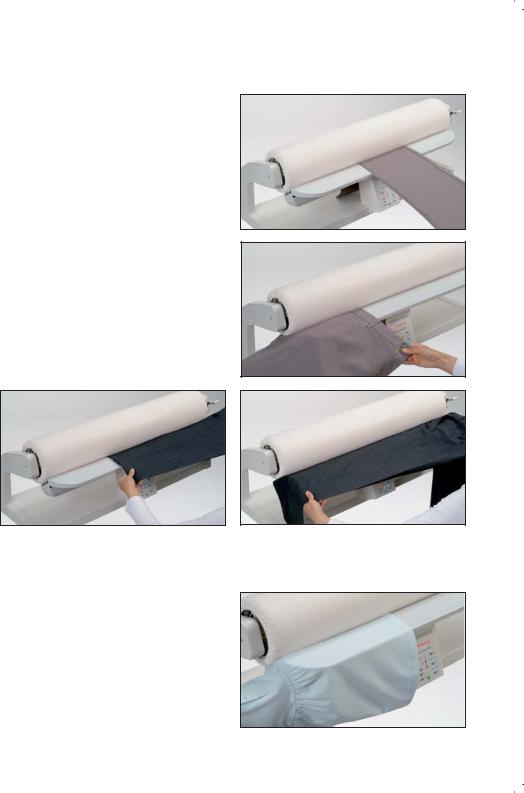
IRONING TROUSERS
1.Iron the legs separately on both sides from the bottom up to the crotch seam.
2.Pull the top part of the trousers over one free end of the heating shoe. Make sure that the zipper is facing upwards toward the iron roller. Iron the top of the
trousers working from the center back to the center front.
3.For crisp crease in the leg, press again as pictured. Starting at the hem area, fi rst press the bottom front crease and then the back crease.
4.Now pull the trousers to the left and press the top break in the crease from both sides.
Note: For some fabrics, it is advisable to place a damp cloth over the heating shoe, to prevent any shiny areas from appearing on the fabric.
3
IRONING RUFFLES OR FOLDS
Ruffles or folds are always ironed at a free end of the heating shoe. Iron slowly.
How to use
1
2
4
19
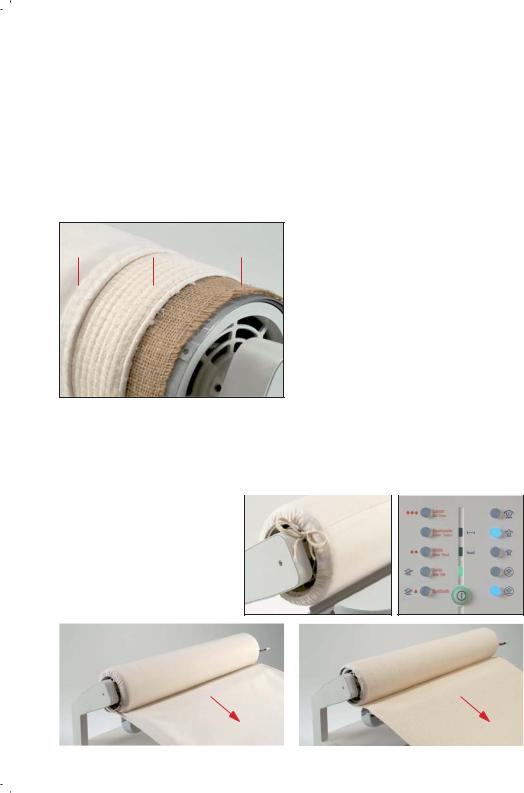
Care & Maintenance
CARE & MAINTENANCE
This chapter contains information with regard to the care and maintenance of your SINGER® Rotary Steam Iron.
For your own safety, always switch off the power switch of the Rotary Steam Iron and unplug when servicing the machine.
GENERAL CARE
To clean the Rotary Steam Iron, use a soft, dry, clean and lintfree cloth. Particularly stubborn dirt can be removed using a soft cloth and a commercial cleaning agent.
Use a commercial cleaning agent to clean the ironing sole plates. Never scratch or scrape the heating shoe.
A B C
If it is necessary to renew the ironing roller cover, only use the original SINGER® ironing cloths and original SINGER® padding covers obtainable from our website at www.singerco.com.
REPLACING OR RENEWING THE IRONING ROLLER COVERS
The ironing roller covers may only be replaced when the heating shoe is cold.
The ironing roller is covered by three layers.
A – Ironing cloth of grey cotton, replaceable. This cover can be washed at 86° F (30° C). However, there is a risk the cover shrinks when washed. In this case, we recommend fi tting a new ironing cloth.
B – The soft padded cover is replaceable. This cover may not be washed but should only be shaken out slightly.
C – Jute cover, not replaceable
UNWINDING THE IRONING COVERS
1. |
Pull out the cord loops at both ends of the roller and |
4. Press the foot pedal again and pull the padding cover |
|||
|
open the loops. |
(B) forward to remove. The jute cover (C) remains on the |
|||
2. |
Switch on the Service function: Press and |
roller. |
|||
|
|
|
|||
|
hold button 15“Continuous Steam”and the |
|
|
|
|
|
|
|
|
|
|
|
power switch. The heater for the heating |
|
|
|
|
|
shoe is switched Off in this mode. |
|
|
|
|
3.Press the foot pedal and pull the ironing cloth (A) forward to remove. This causes the ironing roller to rotate in reverse without
a closing function.
1 |
2 |
|
3 |
|
4 |
|
|
|
20
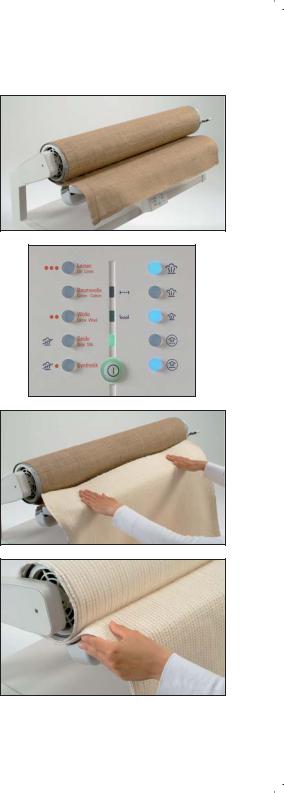
WINDING THE IRONING COVERS
Note: All layers must project evenly and be centered at both sides of the ironing roller so that the roller remains open for ventilation.
1.Unwind the jute cover (C) approximately 10 inches (25cm).
2.To wrap the ironing roller, press the buttons of steam settings min 17A and maximum 17C. This means that the ironing roller will remain in the lowered position even when the foot pedal is operated.
3.The padding cover has a smooth and rough side. Only one short side of the cover is trimmed. Place the trimmed short side on the jute cover with the rough side upwards. Press the foot pedal and wind the padding cover onto the ironing roller.
4.When winding on the padding cover, make sure that the cover is aligned at the left and right with the ironing roller. To do this, spread the padding cover smoothly to the right and left by gently brushing with your hands as the pad is rolling on, causing it to slightly expand outward. After winding on the padding cover, allow the ironing roller to rotate for approximately ten turns.
Care & Maintenance
1
2
3
4
21
